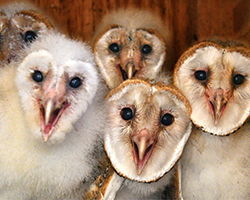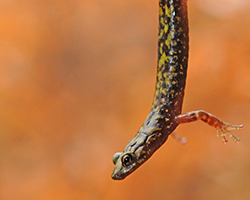Main Content
Article
Nongame and Endangered Wildlife
In 1973, the state legislature passed the Nongame and Endangered Species Conservation Act (IC 14-22-34), which authorized the Indiana DNR to develop programs to manage and conserve nongame and endangered species.
A nongame animal is any wild mammal, bird, reptile, amphibian, fish, mollusk, and crustacean that is not hunted or trapped for sport or commercial use.
Endangered species are any animal species whose prospects for survival or recruitment within the state are in immediate jeopardy and are in danger of disappearing from the state.
Special concern species are those that require monitoring because of known/suspected limited abundance or distribution; have had a recent change in legal listing status; or have had a change to the required habitat needed for survival. Special concern species do not receive legal protection under the Nongame and Endangered Species Conservation Act.
Funding for Nongame and Endangered Wildlife
- In 1982, the state legislature established the Indiana Nongame Wildlife Fund. This dedicated fund supports nongame and endangered species conservation in Indiana. The fund does not receive any state tax dollars and is supported entirely by voluntary contributions. Hoosiers have generously donated more than $13 million since the fund was established.
- In 1986, the Indiana DNR signed an Endangered Species agreement with the U.S. Fish & Wildlife Service (USFWS). For the first time, Indiana was eligible to receive federal matching funds for projects to benefit species listed by the federal government.
- In 2001, additional federal funds became available through the State Wildlife Grant program, also administered by the USFWS. These dollars must be used to benefit a state’s Species of Greatest Conservation Need (SGCN), as identified in its Wildlife Action Plan. Indiana defines a SGCN as one that is listed as state endangered or state special concern. To date, Indiana has received nearly $20 million in State Wildlife Grant funds.
Today, staff in the Division of Fish & Wildlife lead statewide programs to benefit Indiana’s nearly 160 SGCN in the following four species groups: mammals, birds, reptiles/amphibians, and fish/mollusks.
Birds
- Bald Eagles
- Bald Eagle Identification
- Barn Owls
- Barn Owl Nest Web Cam
- Cardinals
- Hawks
- Indiana Birds
- Indiana Breeding Bird Atlas
- Loggerhead Shrikes
- Osprey
- Peregrine Falcons
- Peregrine Falcon Identification
- Sandhill Crane
- Sandhill Cranes Fall Migration
- Whooping Cranes
Fish & Freshwater Mussels
- Freshwater Mussels
- Get Help With Fish Identification
- Indiana Fish
- Indiana Freshwater Mussels
- Minnows of Indiana
Mammals
- Mammals of Indiana
- Allegheny Woodrat
- Badger
- Bobcat
- Bats in Indiana
- Indiana Bat
- White Nose Syndrome
- Acoustic Bat Surveys
- Summer Bat Roost Monitoring


